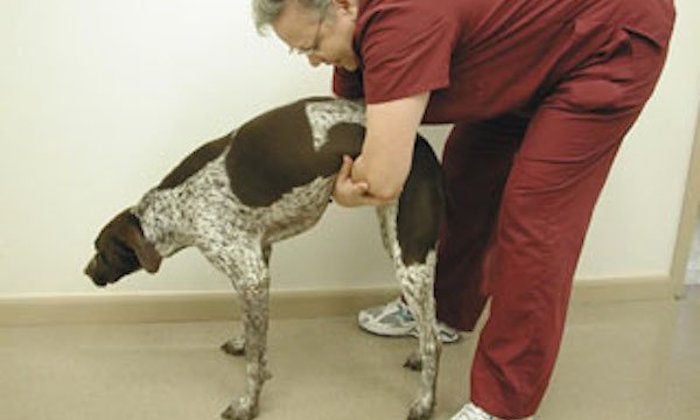How to Identify Canine Ear Conditions and Clean Your Dog’s Ears Effectively
Illnesses involving the ear represent one of the most common reasons that guardians take their dogs to veterinarians. Accordingly, cleaning your dog’s ears regularly is a key part in keeping your dog healthy. Canine ears that are well-looked after are clean, odor-free, pale pink in color and minimal accumulation of wax.
By checking your dog’s ears regularly, you are also more likely to notice if there are any problems your dog may have with his/her ears that may need attention.
Symptoms of Ear Conditions
Canine ears are susceptible to infection and inflammation from a number of different causes. The canine ear is made up of the external ear (externa), the middle ear (media) and the inner ear (interna). Each of these anatomical parts can become inflamed, irritated or infected, causing distinct symptoms which are referred to medically as “otitis” (e.g. otitis externa) which means inflammation of the ear.

Dogs get ear infections, inflammations, microscopic ear mites, fleas, debris and foreign bodies in their ears, which can endanger your dog’s health and hearing. When inspecting your dog’s ears, if you notice any of the following problems, contact your veterinarian:
- Bad, pungeant smells
- Ear discharge
- Redness
- Swelling
- Crusty or flakey skin
- Hair loss
- Cuts and abrasions
- Abnormal lumps or bumps
- Blood from the ears
- Waxy build up (brown or black ear wax or ear wax that is dry and looks like coffee grouds are signs of possible ear mite infestation)
- Thickening (hyperplasia) of the ear flaps
If you observe any of the following behaviors in your dog, you should call your veterinarian.
- Continual head shaking or head/face rubbing
- Constant head tilting
- Hearing loss (does not respond to sounds normally)
- Intense ear scratching
- Wincing or withdrawing when you touch or manipulate the ears
- Lethargy, lack of energy
Common Causes of Ear Ailments
Most ear ailments in dogs are caused by moisture, allergies, foreign objects and parasites.
Moisture: Moisture inside the ear can cause yeast and bacterial infections, so it is important if your dog swims or gets his/her ears wet regularly that you ensure they are dried as much as possible, especially if you live in a moist/humid climate and especially if you have a dog with low-set and low-hanging ears such as Cocker Spaniels, Basset Hounds, and Bloodhounds. Dogs with these type of ears are more prone to developing ear infections.
Yeast and bacterial infections cause a number of adverse symptoms, including ears that are itchy, swollen, smelly, sore and painful. Veterinarians will prescribe antibiotics for bacterial infections and antifungals for yeast / fungal infections.
Allergies: Allergies, such as food allergies, also can also cause ear problems. Dogs commonly shake their head or constantly scratch their ears if they have an allergic reacation, in order to try and relieve the swelling and itchiness. Sensitive ear tissue can be damaged by frequent head-shaking and dog’s can scratch themselves until they bleed, so continual scratching and head shaking should not be ignored.
Foreign objects: Dirt and plant debris are the most common elements that enter a dog’s ears. If the debris makes its way down the ear canal it can cause an infection. Also if foreign objects travel down the ear canal, the could cause perforations to the ear drum and other internal damage to an ear. In the case of certain foxtail grasses, the sharp seed awns can cause serious damage. Read more about foxtails in our article: Foxtail grasses can be lethal to dogs.
Fleas, and microscopic ear mites: These common parasites are often contracted from dog to dog. Ticks also like to latch on to dog’s ears for the easy blood supply.
These parasites will often leave tell-tale signs. Fleas leave dried blood that looks like pepper flecks. Ear mites leave black/brown debris that look like coffee grounds.
Ticks will look like small smooth lumps attached to your dog’s ear or lumps if they have burrowed under the skin. Read more about ticks in our article: How to remove ticks.
It’s important to act quickly if you notice any problem with your dog’s ears to prevent any permanent damage to hearing or a spread of infection.
Preventing Ear Conditions By Cleaning Your Dog’s Ears
Prepare to clean your dog’s ears by having the following items: cotton balls or sterile guaze, and antiseptic cleaning solution specifically created for dogs’ ears (veterinarians often sell these products). Always consult with your veterinarian first before using any ear cleaning product or home-made solution to ensure you are cleaning your dog’s ears appropriately and safely.
NEVER use alcohol or Q-tips to clean your dog’s ears. Alcohol will irritate your dog’s skin and may cause an allergic reaction and Q-tips can damage a dog’s ear drums and force debris and foreign objects further down the ear canal.
- Find a comfortable place to sit with your dog. Have the cotton balls (or guaze) and cleaning solution ready.
- Gently flip your dog’s ear over so you expose your dog’s ear opening.
- Use the cotton ball with cleaner solution on it and gently wipe away any debris and ear wax. Wipe all around the top inside area the ear that you can see. Do not clean areas down the ear canal.
- Use a fresh piece of guaze or cotton ball on the other ear.
- If you notice any inflamation, bad odor, swelling or any other abnormality, do not clean the ear. Instead consult your veterinarian.
The following video demonstrates this cleaning technique as well as how to do a deeper cleaning (ear flush).
Disclosure: This article contains affiliate links. As an Amazon Associate, we may earn a small commission from qualifying purchases made via these links.






